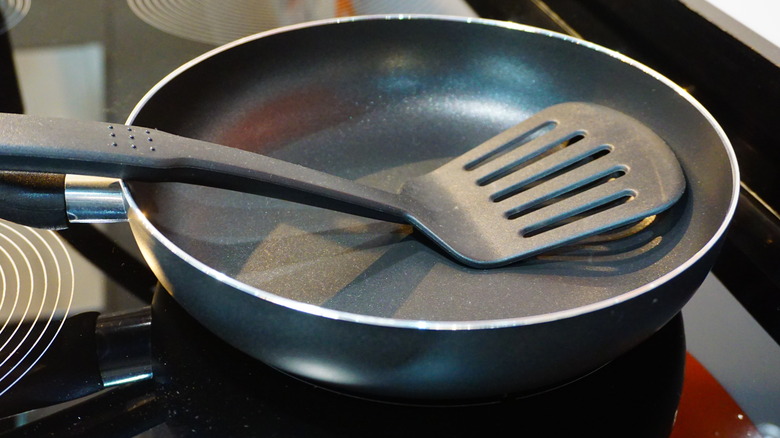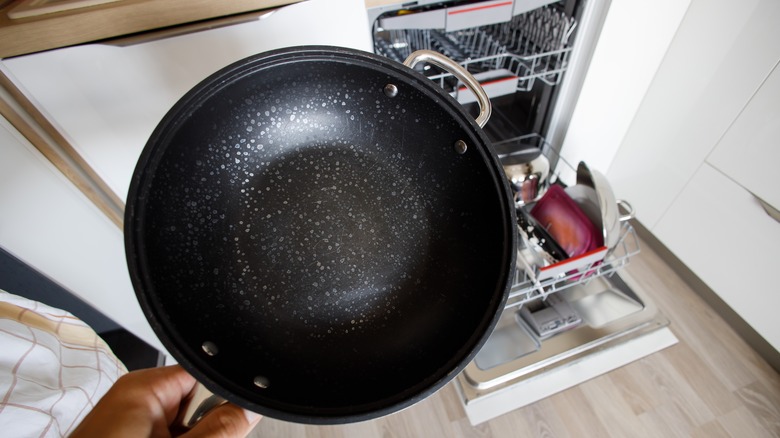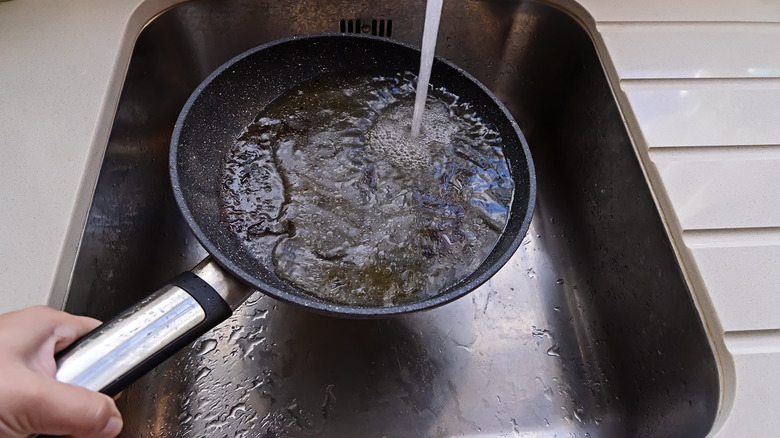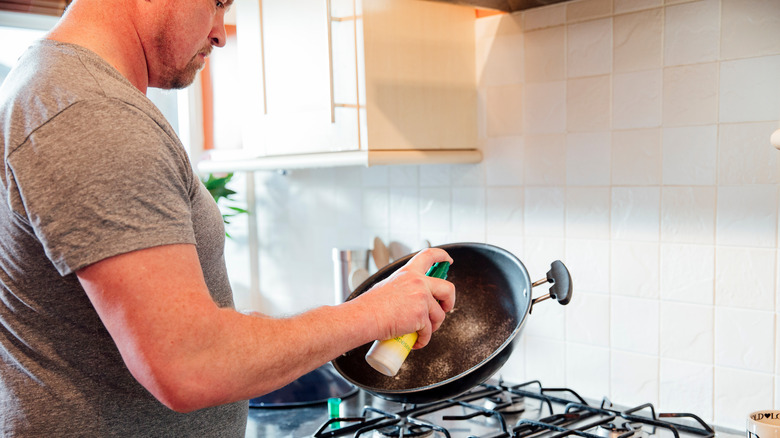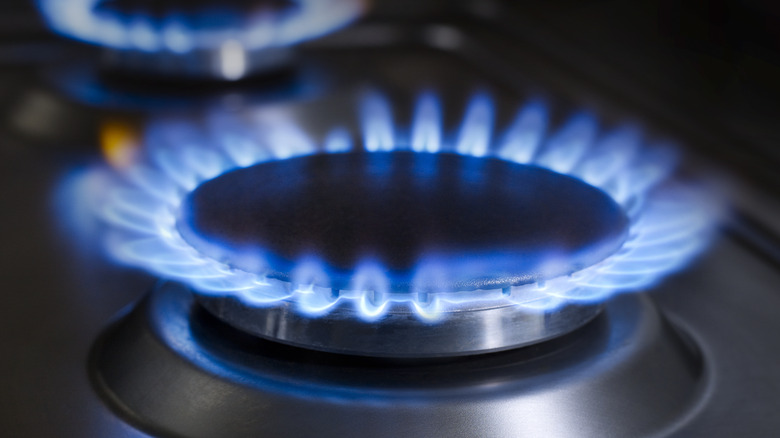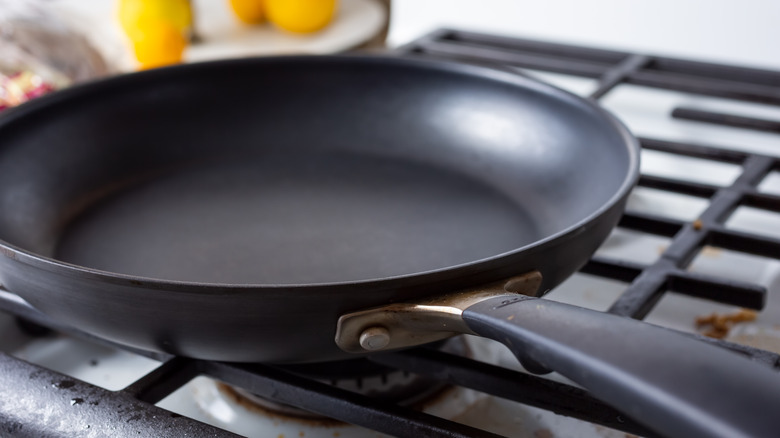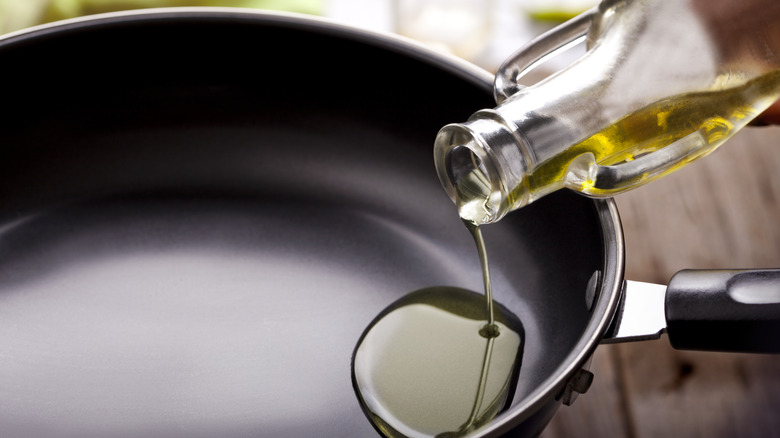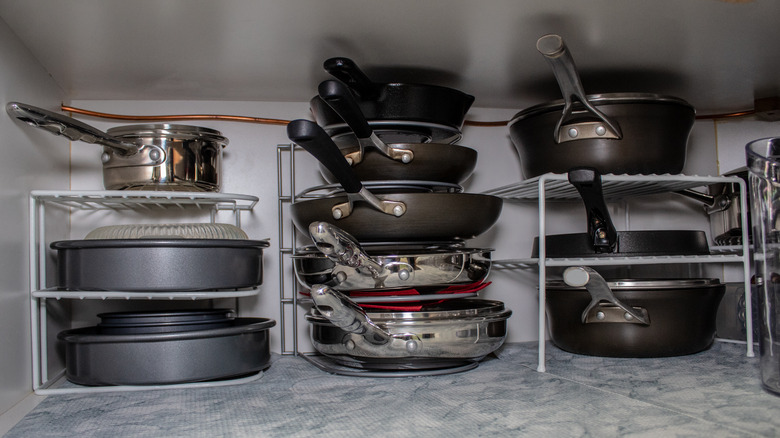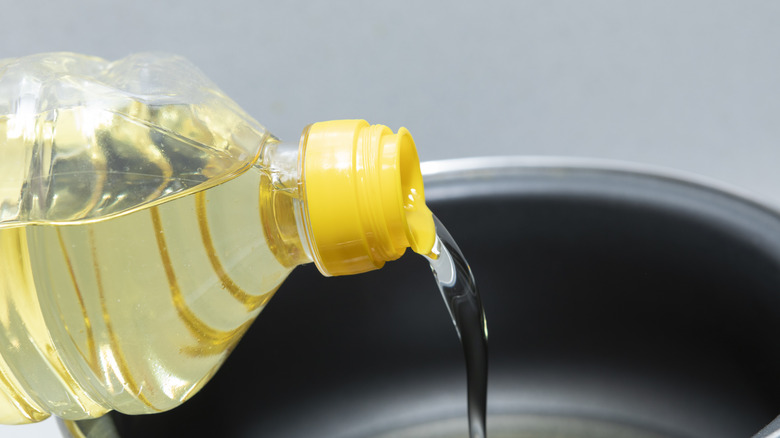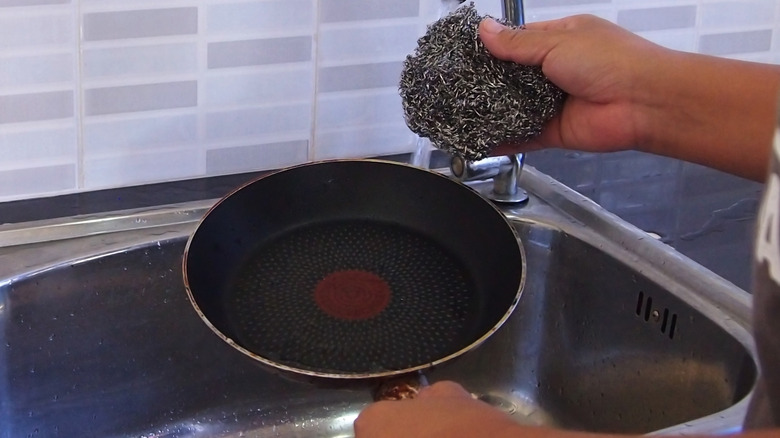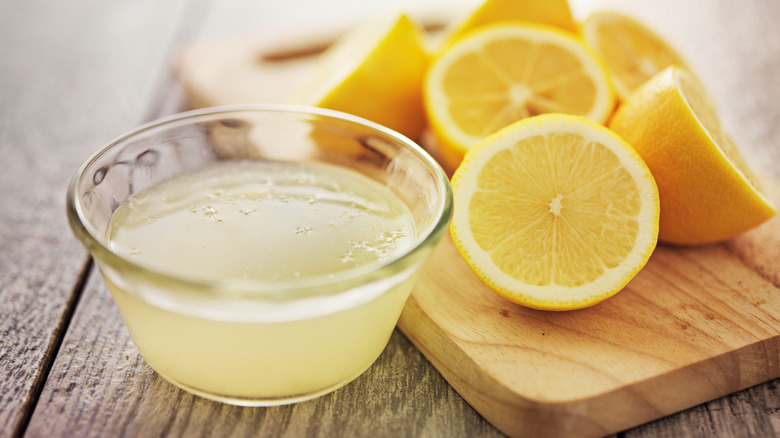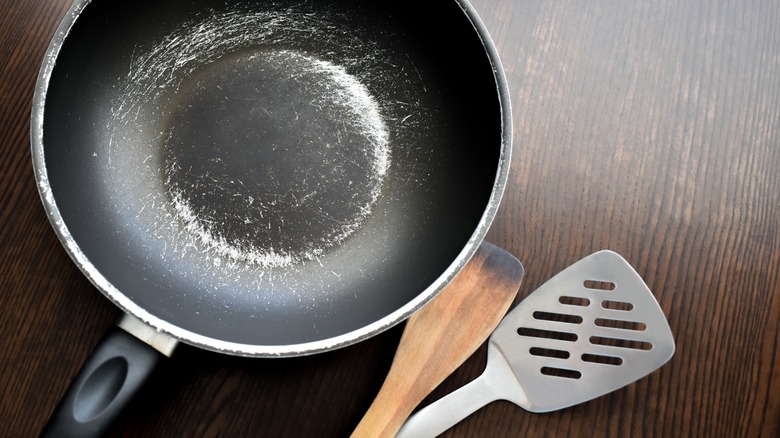Mistakes That Are Ruining Your Non-Stick Pans
Non-stick pans are a home cook's best friend. With their nearly magical ability to cook up notoriously sticky foods such as eggs or potatoes with no sticking and no surprises, they're a great confidence booster for novice cooks and a stress reliever for experienced ones — few among us would ever think of cooking an omelet in anything else.
The only catch is that non-stick pans are not immortal: Unlike that cast-iron skillet you may have inherited from your grandmother, non-stick pans degrade over time and after a few years, lose their all-important non-stick qualities. (This is why many experts advise against investing in super-expensive non-stick pans, which won't last much longer than cheaper versions). But while you'll have to accept the fact that you'll have to replace your non-stick pans every few years, there are mistakes you can avoid to prolong their useful lifespan and ensure you get the best results when cooking.
Washing non-stick pans in the dishwasher
Washing dishes is everyone's least favorite part of meal prep. And if you're the one doing all the cooking and meal planning along with cleanup, we totally get why you want to just get the chore over with by chucking everything into the dishwasher. You're already exhausted, and besides, that's what dishwashers are for, right? Of course. But as you probably know, dishwashers aren't a great option for the more delicate objects in your kitchen, such as antique china or silverware with pearl insets.
We can count non-stick pans among these delicate items: The non-stick coating on the inside of the pan needs to be handled gently, and the powerful action of a dishwasher, along with harsh dishwasher soaps, can potentially damage it. So to help your non-stick pan last as long as possible, wash it by hand and take care of this before you hit the rest of the dishes. It'll be easier to clean if you get to it before food residue has a chance to dry out and potentially stick to it.
Running cold water over them while they're hot
Experienced cooks know that cleaning as you cook saves you time and stress in the long run. It's easier and more sanitary to work in an uncluttered kitchen, and cleaning things as soon as you're done with them saves you the trouble of having to deal with a massive tower of dirty cooking utensils and pots and pans after each meal. However, if you're an organized cook who automatically puts used pots and pans in the sink and cleans them off as soon as you've finished using them, be careful with your non-stick pans.
While it's smart to rinse off food residue quickly before it has a chance to dry and stick to the pan, be sure to let non-stick pans cool down a bit first and avoid rinsing them in cold water while they're still warm. This can cause pans to warp and lose their ability to heat foods evenly.
Using non-stick cooking spray
Non-stick cooking sprays are great for greasing baking sheets and cake pans, and indispensable if you enjoy baked casseroles but don't want to spend hours soaking and scrubbing the casserole dish afterward. So if you have a non-stick pan that's not always fully cooperative (say an older pan with a bit of wear on its non-stick surface), you might be tempted to use cooking spray as extra insurance against sticking. Don't.
Counterintuitive as it may seem, applying non-stick cooking spray to a non-stick pan won't improve its performance. Instead, it will actually make it worse because these sprays burn at a relatively low temperature, making it easy for them to cook on the pan's surface and stick. Over time, they can form a damaging residue that can destroy your pan's non-stick properties.
When cooking with non-stick pans, it's best to stick with regular cooking oil. And if you're worried enough about sticking that you're tempted to reach for that can of spray, it may be time to replace your pan.
Overheating non-stick pans
Another common mistake many home cooks make is assuming non-stick pans can be used exactly like any other frying pan. In reality, their non-stick surface makes them a bit more fragile, and certain conditions a regular pan can handle without problems can be damaging to a non-stick pan.
Among these conditions is high heat: While non-stick pans are designed to get hot enough to get most foods nice and crispy, their non-stick surface can be damaged by repeated exposure to high heat. Moreover, some non-stick surfaces, such as Teflon, release toxic fumes when heated to high temperatures (500 degrees or more). So, when cooking with a non-stick pan, keep the heat to low or medium. A good rule of thumb is to keep an eye on your cooking oil as you cook. If it starts to smoke, it's a sign it's time to turn down the heat.
Heating them while they're empty
A common piece of advice to prevent fried foods from sticking to cast-iron or stainless steel skillets is to heat them thoroughly before adding cooking oil or fat. This helps ensure that the oil distributes itself more evenly and thus forms a smooth, non-stick surface for any food being cooked. In addition, a thoroughly preheated dry pan is great for putting a good sear on a steak or other meat. Preheating a dry pan, however, is generally not a good move for non-stick pans.
While some manufacturers say it's safe to dry heat their pans over low or medium heat, out of an abundance of caution, many experts warn against the practice. The sensitivity of non-stick surfaces to high heat makes non-stick pans more vulnerable to damage or off-gassing dangerous fumes if heated empty. And since non-stick pans are designed to keep food from sticking in the first place, there's no need to preheat them dry as you would other pans.
Not seasoning them before using for the first time
Because non-stick pans are so convenient and simple to use, it's easy to assume they are inherently low-maintenance. But to get the best performance from your pan, and to ensure it keeps its non-stick properties for as long as possible, you need to treat it with care — and this care starts before you cook your first meal. Just as cast-iron pots and pans need to be seasoned before use to ensure a smooth, even inside surface that discourages sticking, so do non-stick pans.
Luckily, seasoning a new non-stick pan is faster and easier than seasoning a cast iron pan. First, wash the pan in hot, soapy water to remove any bits of glue or other packaging material. Rub a thin layer of cooking oil into the inside surface of the pan, then heat it over low to medium heat on the stovetop for about three minutes. Take the pan off the heat and wipe out any remaining oil once the pan has cooled. This quick process will help fill in any small gaps or pores in the non-stick coating and help it function at its best.
Not protecting the non-stick surface during storage
Here's another piece of disturbing news: You may well be damaging your non-stick pans when you're not even using them. Even if you're conscientious about how you treat your non-stick pans when you're cooking and use care when cleaning them, these are not the only times their sensitive interior surfaces are vulnerable to damage.
Think about where and how you store your pans. If you're like many of us, you may have your skillets neatly stacked on a shelf somewhere in your kitchen. This is all well and good, but if your non-stick skillet is in the middle of that stack and other pans are being regularly moved around, this could easily scratch or ding the inside of your non-stick surface (and yes, it really is that fragile). To keep the non-stick surface safe in storage, line it with a towel or napkin to protect it from direct contact with other pans if you store it stacked.
Cooking with oils with low smoking points
While non-stick pans make cooking many finicky recipes easier, it's important to remember they can be finicky themselves and do not play well with every ingredient in your kitchen. And while they do allow most foods to slip around freely without sticking, some ingredients will stick stubbornly to the surface in certain conditions. Among these are cooking fats and oils with low smoking points.
Because these burn at relatively low temperatures, they can easily degrade and stick to a hot pan before the rest of your food has had the chance to cook. This can cause permanent damage to your pan and its non-stick properties. Your safest bet for protecting your pans is to choose oils with high smoke points (such as canola and coconut oil). If you love the flavor of fats with lower smoke points (such as olive oil or butter), use them for low-heat cooking or add them at the end for flavoring.
Using abrasive scrubbers or cleansers on non-stick pans
It's not supposed to happen, but food occasionally does get stuck to non-stick pans, especially if your pan is old or has a damaged surface. But no matter how stubbornly burnt-on food may want to cling to your pan, it's critical to use a gentle touch when cleaning it off. Using abrasive scrubbers such as steel wool or gritty cleansers may work great on other pans, but can seriously damage a non-stick surface. And this will make your sticking problems even worse the next time you use the pan.
Instead, be patient and use a soft sponge or washcloth and gentle soap to clean out the interior of your non-stick pan. Soaking pans in warm water and soap can help loosen stubborn bits of burnt-on food and make removal easier. If you're facing a lot of burnt-on buildup, you can make a gentle cleansing paste by moistening baking soda with water. Apply this paste with a damp sponge and gently scrub until the residue dissolves.
Cooking with acidic ingredients too often
Tangy, acidic ingredients such as tomatoes, citrus, and wine are staples for many cooks and offer a welcome pop of brightness to otherwise heavy or bland dishes. But as many cooks know, they can interact with cookware in undesirable ways; acidic foods can leach lead from ceramic cookware and corrode the seasoned surface of cast-iron pans, for example.
In addition, they can accelerate the breakdown of non-stick pan surfaces by causing them to blister. And if the inside surface of your non-stick pan has any scratches, acid making its way through these scratches can potentially leach out the aluminum lining beneath the non-stick coating. This can give your food an off flavor. So while a squeeze of lemon to top off freshly fried fish or a garnish of chopped tomatoes won't instantly destroy a non-stick surface, you might want to consider using a different pan if you're planning a meal showcasing these tangy flavors.
Using metal utensils when cooking in them
The inside surface of a non-stick pan looks as if it could handle anything. And while a non-stick pan in good condition is more than capable of repelling eggs or pancake batter – and new non-stick pans are much more durable than they were in the past – the non-stick surface itself still needs to be treated with a gentle hand if you want to keep working as intended. This may mean breaking a lot of old habits you may have developed using other pans. For instance, you may love your dependable metal spatula and regularly rely on your favorite pair of metal tongs for flipping fried foods. But if you're cooking in a non-stick skillet, you need to rethink these practices.
Metal can scratch non-stick coatings and cause permanent damage. (For the same reason, avoid using a knife to cut food while it's in a non-stick pan). Instead, reach for wooden or plastic utensils to get your food in and out of a non-stick pan. You'll be protecting your pan and making your future cooking projects easier.

